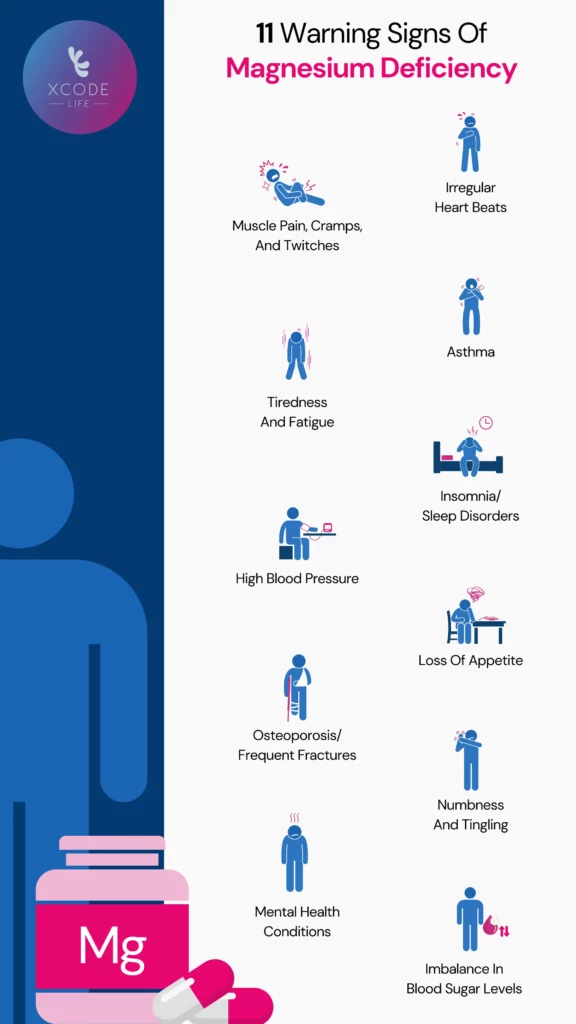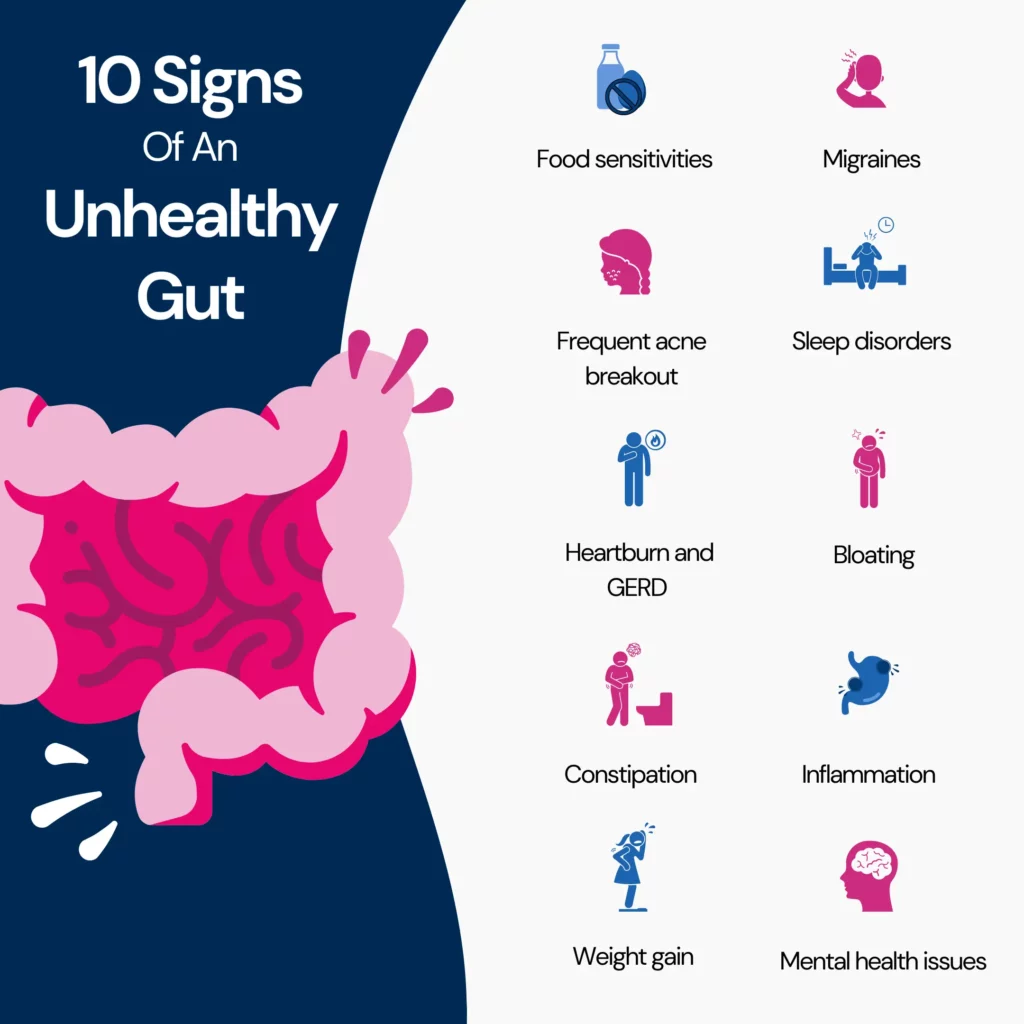Magnesium is an all-rounder mineral that plays a crucial role in everything from supporting our heart and brain functioning to maintaining our muscle and bone health. Despite its importance, statistics suggest that almost 50% of Americans aren't getting enough magnesium daily. This shortfall can lead to a host of health issues. From sleep disturbances to muscle cramps, this article discusses 11 warning signs of magnesium deficiency and how to ensure you get enough of this essential mineral.
Magnesium supports the function of over 300 enzymes that play a role in numerous body processes like liver detox and digestion, making this mineral essential for a healthy body.
Some key roles of magnesium include supporting muscle relaxation, energy production, bone health, nervous system functioning, and heart health.
Hence, a deficiency of this mineral can wreak havoc on the body.
Magnesium deficiency occurs in the following situations:
Let’s discuss the causes and risk factors of each
Once magnesium enters the body, it must be taken to all the correct places, and enough of it should be reabsorbed in the kidneys during excretion.
Certain genes influence this process:
People with variations in these genes may be at a higher risk of magnesium deficiency due to poor regulation in the body.
Hand-picked Article For You: How Genes Influence Magnesium Requirements
Inadequate magnesium in the diet, certain health conditions and medications, excess excretion, and variations in genes that regulate magnesium levels can all deplete magnesium in the body.
It is important to note that phytic acid and insoluble fiber have numerous health benefits and should be part of your daily diet.
Overconsumption should be avoided to prevent the blocking of magnesium absorption.

Cramping and twitching of muscles is often a sign of magnesium deficiency.
Studies indicate that this could result from an imbalance between calcium and magnesium levels, resulting in excess flow of calcium into nerve cells.
This can overstimulate them, causing them to twitch and cramp.
Fatigue describes both physical and mental exhaustion.
Magnesium is crucial for energy production as it is involved in ATP (energy molecule) synthesis.
Thus, its deficiency can bring energy levels down.
Further, magnesium also impacts potassium levels, which is associated with muscle fatigue.
Magnesium is involved in muscle relaxation, which includes the inner walls of blood vessels.
When the body doesn’t have enough magnesium, the blood vessels may not relax well.
This can cause high blood pressure, increasing the workload on the heart.
Research suggests that magnesium supplements can, in fact, help lower both systolic and diastolic blood pressure.
The favorite nutrient for our bones is calcium and calcium cannot get its work done without magnesium.
Magnesium also helps convert vitamin D to its active form, which is required for calcium absorption.
If deficient in magnesium, it can result in lower levels of calcium, making the bones brittle and weak, thereby increasing the risk of osteoporosis.
Magnesium helps the nervous system relax by regulating the activity of key brain chemicals (neurotransmitters) like serotonin and GABA.
Magnesium deficiency could disrupt the neurotransmitter balance, causing mood swings and irritability and increasing the risk of various conditions like anxiety and depression.
A severe magnesium deficiency may result in irregular heartbeats or heart arrhythmia.
Magnesium plays a role in muscle contraction - even the heart muscles. Further, the heart rhythm is maintained by important electrolytes like sodium and potassium.
Hence, optimal levels of magnesium is crucial to lower the risk of arrhythmias.
Magnesium deficiency can increase asthma risk by constricting the airways in the lungs (due to calcium buildup).
A type of magnesium supplement is used in asthma treatment as it helps relax the lung muscles, allowing free air flow.
Melatonin is a hormone that promotes sleepiness.
Magnesium appears to affect melatonin levels, which, in turn, can affect sleep.
Further, magnesium also directly affects sleep through unknown pathways.
Studies suggest that taking magnesium along with melatonin supplements can enhance its sleep-promoting effects.
Magnesium’s role extends to the digestive system as well. It plays a key role in aiding digestion and regulating appetite.
Lower levels of this enzyme can result in inadequate production of digestive enzymes, leading to nausea and loss of appetite.
Calcium is required for signaling in the nerve cells - how they send and receive messages.
Adequate magnesium levels are necessary for calcium to function properly.
When there’s magnesium deficiency, it may cause abnormal nerve function, leading to numbness and tingling, commonly experienced as “pins and needles” sensation.
Magnesium deficiency is common in people with type 2 diabetes.
This is because magnesium increases the sensitivity of fat cells to insulin thereby promoting glucose uptake and reducing blood sugar levels.
Identify your genetic risk factors for magnesium deficiency with a nutrition genetic test
*reports are generated only using ancestry test DNA data. xcode does not ship out DNA kits.
| Age range | Males (in mg) | Females (in mg) | Pregnancy (in mg) | Lactation (in mg) |
| Birth - 6 months | 30 | 30 | ||
| 7-12 months | 75 | 75 | ||
| 1 - 3 years | 80 | 80 | ||
| 4 - 8 years | 130 | 130 | ||
| 9 - 13 years | 240 | 240 | ||
| 14 - 18 years | 410 | 360 | 400 | 360 |
| 19 - 30 years | 400 | 310 | 350 | 310 |
| 31 - 50 years | 420 | 320 | 360 | 320 |
| > 50 years | 420 | 320 |
Source: ResearchGate
It is important to consult a doctor if you identify signs of magnesium deficiency.
Consuming a diet rich in magnesium or taking supplements (prescribed by a doctor) can help overcome mahogany deficiency.
Further, lifestyle tweaks like cutting down on alcohol, consuming less caffeine, and stress management can also help boost magnesium levels.
By incorporating magnesium-rich foods throughout your day, you can meet 100% of your magnesium requirements.
Here’s a way you can do that:
Magnesium supplements can take a week to start showing results, and it can take around 4 weeks for magnesium levels to come back to normal.
In certain cases of chronic magnesium deficiency, it may take up to 40 weeks.
https://www.healthline.com/nutrition/magnesium-deficiency-symptoms
https://www.medicalnewstoday.com/articles/322191
https://ods.od.nih.gov/factsheets/Magnesium-HealthProfessional
https://medlineplus.gov/genetics/gene/trpm6
https://www.ncbi.nlm.nih.gov/gene/846
https://www.healthline.com/nutrition/magnesium-deficiency-symptoms
https://pubmed.ncbi.nlm.nih.gov/10506126
https://www.ncbi.nlm.nih.gov/pmc/articles/PMC8108907
https://www.ncbi.nlm.nih.gov/pmc/articles/PMC8313472
https://academic.oup.com/qjmed/article/111/11/759/4209351
Did you know that dandruff impacts 50% of the world's population? It results in flakes on the hair and shoulders, along with itching and scalp irritation. Dandruff can have various causes, such as dry skin, fungal infection, or sensitivity to hair products. But is dandruff genetic? Can you inherit it from your parents or pass it on to your children? Read on to explore the possible genetic factors behind dandruff and learn how to prevent and treat it.
Dandruff is not really about your hair but about your skin - specifically, the skin on your scalp.
It has nothing to do with over-shampooing your hair. Dandruff occurs when dead skin cells on the scalp are shed at a faster rate.
Here are some common reasons why one may experience dandruff:
Scientists have found evidence suggesting dandruff may have a genetic component.
They identified 487 genetic markers linked to a higher chance of having dandruff.
This means if someone in your family has it, you have a higher likelihood of getting it.
These genetic factors can affect the immune response and skin cell turnover, leading to the development of dandruff.
However, genes are not the sole contributors. Factors like lifestyle and environment also play a role in this condition.
We still need more research to fully understand how genes and other elements work together to cause dandruff.
One potential reason for dandruff is linked to how our genes interact with tiny living things called microbes on the scalp.
Similar to the way microbes reside in our gut, they also live on our scalp.
Some individuals may have variations or changes in genes related to immune responses or skin barrier function.
This potentially could lead to an exaggerated inflammatory response to fungal colonization on the scalp, which is a common trigger for dandruff.
Although scientists are unsure why some people are sensitive to these microbes, and others aren't, it's possible that genetics play a role in determining this sensitivity.
Certainly, dandruff can be inherited, with sensitivity to oleic acid being a contributing factor.
This sensitivity arises from the interaction between a naturally occurring microbe (Malassezia globosa) and scalp oils (sebum).
The development of dandruff is influenced by this genetic predisposition, which can be passed down from parents.
Therefore, for around 50% of the global population, the tendency to experience dandruff may be hereditary.
Those lacking sensitivity to oleic acid are less prone to dandruff.
Did You Know?
Many aspects of your skin health and aging, including the risk for conditions like adult acne, rosacea, tanning, and the likelihood of premature wrinkles, stretch marks, cellulite, etc., are highly influenced by your genes. You can learn in-depth about your skin using your existing ancestry genetic test DNA data.
Dandruff has the potential to affect individuals at any age, with its prevalence shifting through different life stages:
Dandruff isn't a lasting problem; its duration depends on the underlying cause and how effectively you handle it.
Usually, it begins in young adulthood and carries on through middle age. However, this doesn't exclude older adults from experiencing dandruff.
In fact, for some individuals, it can persist throughout their entire lives.
The strength and occurrence of dandruff can also shift over time as the scalp ages and undergoes changes in moisture levels.
Genetic dandruff is a condition that causes your scalp to produce too many dead skin flakes.
It occurs due to genetic changes that affect how your scalp's natural oil, called sebum, is regulated and your immune response.
While genetic dandruff might be embarrassing and uncomfortable, you can prevent it with simple steps:
By following the above steps, you can stop genetic dandruff and have a healthy, flake-free scalp.
Genetic dandruff is not curable, but it is treatable. The available treatment options depend on the severity of the condition and individual preferences.
Various treatments are accessible in addition to the preventive measures mentioned earlier.
Many over-the-counter medicated shampoos and scalp treatments contain antifungal or antibacterial ingredients to lessen dandruff.
If these products don't yield results within 2–3 weeks, it's advisable to consult a doctor. They can assess whether prescription shampoos or medications would be more effective.
Healthcare professionals might recommend topical antifungal medications, corticosteroids, or immunomodulators to address dandruff and other skin conditions.
Dandruff, a common scalp condition impacting millions globally, is not only influenced by external factors like dry skin or fungal infections but also has a genetic component.
Scientists found 487 genetic markers for dandruff, highlighting the significant role of genetics in determining susceptibility to conditions.
This hereditary tendency, affecting approximately 50% of the global population, is related to sensitivity to oleic acid, a microbial interaction in the scalp.
While dandruff is not curable, it is treatable through various means, including over-the-counter medicated shampoos and, in severe cases, prescription medications.
Managing genetic dandruff involves maintaining scalp health, using specialized shampoos, avoiding harsh chemicals, and addressing stress levels.
Understanding the genetic roots of dandruff allows individuals to take proactive steps in treatment and prevention, promoting a healthy scalp.
Regular care, including proper hygiene, choice of hair products, and stress management, is crucial in managing genetic dandruff and promoting a flake-free scalp.
https://www.mayoclinic.org/diseases-conditions/dandruff/symptoms-causes/syc-20353850
https://onlinelibrary.wiley.com/doi/10.1002/bies.202100005
https://www.health.harvard.edu/skin-and-hair/what-is-the-best-way-to-treat-severe-dandruff
https://www.medicalnewstoday.com/articles/152844
https://www.healthline.com/nutrition/ways-to-treat-dandruff
Anxiety can significantly impact how your brain functions, particularly in areas responsible for responding to threats and managing stress. When anxiety strikes, it can make certain parts of the brain overly active while hindering others. For example, the prefrontal cortex, which helps us process information and make rational decisions, can become less effective. This happens because anxiety weakens the connection between the prefrontal cortex and the amygdala, the part of the brain that processes fear and danger. As a result, people with anxiety may find it harder to cope with stress and fear, making everyday challenges feel overwhelming. Let's explore further how anxiety affects the brain and what this means for those experiencing it.
Anxiety is a normal emotional response to stress and threat.
Occasional anxiety to stressors like an important job interview or an exam is fine.
Anxiety disorders are different from this. They’re a group of conditions characterized by persistent feelings of anxiety, fear, and stress.
Some symptoms of anxiety include:
The cause of anxiety is still unclear, but it appears to be a combination of genetic, environmental, and psychological factors.
In the past, scientists believed that the amygdala, a region deep within the brain, was solely responsible for fear and anxiety.
However, current research suggests that anxiety arises from complex interactions among various brain regions rather than being driven by a single area, like the amygdala alone.
The Dorsal Anterior Cingulate Cortex (DACC) is involved in processing fear signals from the amygdala.
When individuals with anxiety view fearful stimuli, the DACC and the amygdala enhance their communication.
This increased interaction contributes to heightened anxiety levels in individuals with anxiety compared to those without.
The ventromedial prefrontal cortex, located in the frontal lobe, is also involved in regulating anxiety signals from the amygdala.
Damage to this brain region can result in a lack of inhibition of anxiety signals, potentially leading to increased anxiety experiences.
This part of the brain serves as a modulator for anxiety responses rather than solely reducing anxiety signals.
Thus, anxiety is a complex phenomenon involving various brain regions orchestrating interactions to produce anxious responses.

Image: The Effects of Anxiety on the Brain / Inspired by NewScientist
Anxiety activates the fight or flight response in our bodies.
When fighting off the anxiety trigger(s), the brain releases adrenaline and cortisol, which alert our bodies and help us cope with danger.
When this danger is gone, the sympathetic part of the nervous system takes over and brings a sense of calm.
In people with anxiety, the sympathetic nervous system doesn’t do its job well.
As a result, the stress hormones keep getting released, triggering anxiety symptoms.
Chronic stress and anxiety can lead to structural degeneration and decreased functionality of the hippocampus and the prefrontal cortex.
This can increase the risk for psychiatric disorders, including depression and dementia.
The amygdala is an almond-shaped mass of gray matter in the brain involved with expressing emotions.
It is responsible for responses to fearful and threatening stimuli.
With persistent anxiety, the amygdala increases in size, amplifying the body’s response to scary situations.
The hippocampus plays a major role in learning and memory.
It gets severely affected by many psychological disorders, including anxiety.
In chronic anxiety, the hippocampus shrinks in size.
Any damage to it can cause difficulty recalling memories and forming new ones.
The hippocampus is also responsible for linking a particular place to a fearful event.
This explains why some individuals with anxiety may avoid certain places.
The prefrontal cortex region of the brain is involved in logical responses and reasoning.
It helps process information and make an informed decision to solve a problem.
The connection between the prefrontal cortex and amygdala is weakened in anxious brains.
This can increase the sensitivity to dangers and hamper logical thinking and rationalizing.
The hippocampus is responsible for holding short-term memories and transferring them to long-term storage
With chronic anxiety, the hippocampus shrinks in size, making it difficult to recall memories.
Research has demonstrated that stress and anxiety can modulate hippocampal function, leading to enhanced encoding and consolidation of emotionally arousing or threatening memories.
Studies have found that individuals with anxiety disorders, such as post-traumatic stress disorder (PTSD), tend to have better recall for trauma-related or threatening information compared to neutral information.
Thus, in an anxious brain, the memories of failure, threat, and danger overpower that of success, happiness, and achievement.
In anxiety, the brain tends to hold onto negative memories.
This contributes to other mental disorders like depression.
The five major types of anxiety disorders are:
Generalized Anxiety Disorder, GAD, is a specific anxiety condition marked by persistently elevated tension, anxious feelings, and negative thoughts, even without a force or occasion to trigger them.
Obsessive-compulsive disorder (OCD) is a persistent pattern of evaluations and ritualistic behaviors.
OCD is characterized by unwanted thoughts (obsessions) and repetitive behaviors (compulsions).
Practicing behaviors such as washing hands, counting, checking, or cleaning is typically done with the aim of eliminating thoughts or making them disappear.
However, these "rituals" are only temporary relief, not a solution.
Panic disorder is an anxiety disorder that causes sudden and repeated episodes of intense fear, accompanied by symptoms including chest discomfort, heart palpitations, shortness of breath, dizziness, or stomach distress.
Post-traumatic Stress Disorder, or PTSD, is an anxiety disorder that can develop after exposure to a terrifying event or ordeal that involves impending physical harm.
Traumatic events that may trigger PTSD include traumas arising from violent personal assault, natural or human-caused disasters, accidents, or military combat.
Social Anxiety Disorder (SAD) or social phobia is an anxiety disorder marked by excessive self-consciousness in social situations and overwhelming anxiety.
Depending on the severity of its symptoms, SAD can be limited to only one type of situation, such as a fear of speaking in formal or informal settings.
It also may be so severe that the person may experience the symptoms by simply being around other people.
While there is no one-size-fits-all approach to coping with anxiety, several strategies can help.
Some of these include:
If needed, seek professional therapy to help address your anxiety.
With over 75 million US adults suffering from digestive issues, the phrase "listen to your gut" has transcended being a mere metaphor to become a vital health mantra! Far from being a fleeting health fad, gut health emerges as a cornerstone of overall wellness, playing a pivotal role not just in digestion but also in the operation of virtually every organ system in the body. While pinpointing an unhealthy gut isn't straightforward, certain indicators can serve as red flags. This article discusses the 10 commonly observed signs of an unhealthy gut and some of the most effective lifestyle changes to fix your gut.
About Xcode Life
Calling the gut the body’s second brain would still be an understatement, considering the important roles it plays in our bodies.
By digesting the food consumed and absorbing the essential nutrients from it, the gut fuels and maintains the entire body.
Therefore, it is no surprise that the importance of the gut in maintaining overall health is increasingly becoming an important research topic in the medical community.
| Heart Health | TMAO is a substance made in our gut when we digest certain foods. High TMAO levels in our blood, influenced by our diet and gut bacteria, are linked to heart disease in humans. If we feed our bodies with certain kinds of food, it encourages the gut bacteria to produce more TMAP, thereby endangering our heart health. |
| Kidney Health | Uremic dysbiosis is a pathogenic condition that affects the ability of the kidney to filter properly due to an imbalance in the gut microbiome. Uremic dysbiosis can also be caused by excess plasma TMAO and lead to chronic kidney disease. Medical experts believe treating an unhealthy gut can help prevent uremic dysbiosis or reduce its severity. |
| Immune System | Did you know that 70-80% of immune cells are present in the gut? Therefore, the gut plays a direct role in influencing the immune system, which is why certain types of gut microbiota have been linked to autoimmune diseases. |
| Liver health | Studies report that a leaky gut may cause the movement of gut microbiota to the liver, resulting in the development of liver diseases. The composition of gut microbes can also influence bile metabolism. Issues with bile metabolism lead to liver disorders. |
| Skin Health | Gut health directly affects skin inflammation and influences acne breakouts. The gut also helps in the absorption of essential nutrients like vitamins A, E, and C and fatty acids, all of which are important in maintaining skin health. |
| Mental Health | The gut produces essential neurotransmitters like serotonin and dopamine, which affect mood, regulate sleep, and influence mental health. An unhealthy gut may lead to neurotransmitter imbalances, leading to various mental health issues. |
| Body Weight | The gut produces hormones that control feelings of hunger and satiety. An unhealthy gut may lead to problems in regulating these hormones, causing overeating issues. The gut also determines how nutrients are absorbed, and fat is stored, which also affects body weight. |
Here are ten notable signs of an unhealthy gut.
One of the common signs of an unhealthy gut is food sensitivities. The low quality of gut microbes may make it difficult to digest certain types of food, leading to post-meal problems like bloating, abdominal pain, diarrhea, and nausea.
Migraines cause intense headaches and sensitivities to sound and light. Gut microbe imbalance may play a role in the development of migraines.
Acne is a skin inflammatory condition that causes skin breakouts.
Gut issues could be one reason for recurring acne breakouts.
A 2019 study reports that skin acne is closely connected with the gastrointestinal tract and that the gut microbiota may be involved in the development and severity of acne.
The gut plays a role in regulating the circadian rhythm in the body.
The circadian rhythm is the 24-hour internal clock that tells the body when to sleep and when to stay awake.
Sleep disorders like insomnia, difficulty falling asleep, or excessive daytime sleepiness may all be signs of an unhealthy gut.
Another telltale sign of an unhealthy gut is Gastroesophageal reflux disease (GERD) and frequent heartburn.
Gut dysbiosis is a condition caused by an imbalance in the gut microbes.
A 2019 study reports that gut dysbiosis is a common cause of conditions like GERD, irritable bowel syndrome, and colitis.
Bloating is an excess buildup of gas in the GI tract which can make the belly feel tight, full, and uncomfortable, especially after a meal.
It is mostly a result of digestive issues and hormonal imbalance, both of which are signs of an unhealthy gut.
Gut dysbiosis can be another cause of frequent or chronic constipation.
Studies suggest targeting gut dysbiosis using probiotics, prebiotics, synbiotics, and fecal microbiota transplantation (FMT) to treat constipation.
Inflammation is the body’s way of handling an injury, infection, or sickness and is regulated by the immune system.
The presence of certain types of gut bacteria can trigger the immune system to cause chronic inflammation in all parts of the body.
Chronic inflammation leads to increased risks of type II diabetes, cardiovascular problems, and even certain types of cancers.
The inability to maintain a healthy body weight could be a sign of an unhealthy gut.
The gut microbiomes are responsible for energy expenditure and the absorption of nutrients from food.
The gut microbes also affect the production of ghrelin, leptin, and peptide YY hormones, all of which affect your appetite.
An unhealthy gut may lead to lower energy expenditure and nutrient absorption and keep you feeling hungry, leading to weight gain issues.
The gut and the brain are very closely connected and can affect one another. The gut is called the second brain for this reason.
Psychological problems can lead to GI issues, while an unhealthy gut can be the root cause of conditions like stress, anxiety, or depression.

The following are some of the factors that affect gut health.
One of the major factors that affect gut bacteria is the food consumed.
A diet rich in vegetables and fruits may help develop a more diverse gut microbiome, while consuming excess processed food may damage intestinal linings and result in the presence of only a limited species of gut microbes.
A 2008 study suggests that a Western diet rich in saturated fats and sugar reduces the levels of Bacteroides (beneficial gut microbes) and increases the levels of firmicutes (bad gut microbes).
Several studies relate an increased ratio of firmicutes to Bacteroides to type II diabetes and obesity.
Some studies report that non-digestable dietary components called probiotics may help diversify gut microbiomes, improving gut health.
Aging is a factor that affects gut health. As people age, the gut microbe diversity decreases, marked by increased inflammation and digestive issues.
The gut microbiome makeup is also dependent on genetics.
Changes in certain genes can influence the presence or absence of certain gut microbes, thereby influencing gut health.
Long-term use of certain medications may affect gut health by altering the microbiome makeup.
For instance, antibiotics, used to treat bacterial infections, can destroy beneficial bacteria in the gut, leading to gut issues like inflammation and digestive problems.
Many studies report that the use of metformin to treat type II diabetes changes gut microbial patterns, affecting gut health in the long term.
A 2016 study reports that the gut microbiome pattern is different between infants born via vaginal delivery and those born by cesarean section.
According to the study, infants born by vaginal delivery are exposed to the mother’s bacteria at birth, which isn’t the case for infants born through a cesarean section.
The following are some of the health conditions that could be associated with an unhealthy gut.
A gut bacterial imbalance can show up as chronic digestive issues, skin breakouts, mental health issues, unexpected weight fluctuations, sudden food intolerances, or migraines.
There are specific tests that can help identify microbiome imbalance levels in the gut. This would help in making precise treatment plans.
Including different varieties of plant-based foods in your diet is a very easy way to improve the gut microbiome pattern and general gut health.
Whole foods are also great for maintaining a healthy gut.
Naturally, fermented foods contain different types of live microorganisms, which benefit the gut.
These foods are natural probiotics and must be included in plenty in one’s diet.
Some of the common types of fermented foods are yogurt, kefir, kombucha, kimchi, and pickled vegetables.
According to experts, processed foods that contain excess emulsifiers damage the lining of the intestinal walls, promote inflammation, and result in a leaky gut.
Reducing the consumption of processed food and choosing fresher and more natural ingredients is one way of protecting the gut.
Water is essential for optimal gut health - it helps break down food and prevent constipation and gut inflammation.
Probiotics are supplements or types of food that contain live microorganisms, while prebiotics are food that may help improve the gut microbiomes.
Most fiber-rich foods are prebiotics.
Including both prebiotics and probiotics would help diversify the microbiome pattern and improve gut health.
Stress affects every single organ in the body, including the gut.
Studies report that chronic exposure to stress may change brain-gut interactions and trigger gastrointestinal problems like IBD.
Moderate physical activity is one of the proven ways of diversifying gut microbiota and improving gut health.
According to a 2016 study, exercise could be an alternative therapy to deal with gut dysbiosis and related conditions.
There is no one magic supplement that would instantly improve gut health.
Instead, including the following supplements regularly in one’s diet may help improve gut health and diversify gut microbiota.
Processed foods, deep-fried foods, and artificial sweeteners in excess are three foods that can affect gut health.
Multiple studies report that caffeine in coffee diversifies gut microbiota and helps increase the number of beneficial bacteria growing in the gut.
Bad gut bacteria thrive on processed foods, excess sugar, alcohol, gluten, and dairy.
Eliminating or restricting these kinds of foods may be a way to starve bad bacteria.
Hand-picked content for you: Beating Bad Gut Bacteria: Starve Them!
There is no quick fix to improve gut health.
Choosing fiber-rich meals, staying away from processed and refined foods, staying physically active, and including probiotic supplements can all help improve gut health over time.
https://www.ncbi.nlm.nih.gov/pmc/articles/PMC4191858/#:
https://pubmed.ncbi.nlm.nih.gov/22797518/
https://www.ncbi.nlm.nih.gov/pmc/articles/PMC3427212/
https://www.nature.com/articles/s42255-021-00348-0#
https://www.ncbi.nlm.nih.gov/pmc/articles/PMC4528021/#
https://www.ncbi.nlm.nih.gov/pmc/articles/PMC5483960/
https://www.ncbi.nlm.nih.gov/pmc/articles/PMC4570153/
https://www.ncbi.nlm.nih.gov/pmc/articles/PMC4681099/
https://www.ncbi.nlm.nih.gov/pmc/articles/PMC5062956/
https://www.ncbi.nlm.nih.gov/pmc/articles/PMC6678709/
https://www.ncbi.nlm.nih.gov/pmc/articles/PMC6702393/#
https://www.ncbi.nlm.nih.gov/pmc/articles/PMC6379309/
https://www.ncbi.nlm.nih.gov/pmc/articles/PMC4976518/
https://www.ncbi.nlm.nih.gov/pmc/articles/PMC10096519
https://www.ncbi.nlm.nih.gov/pmc/articles/PMC7589951/
https://www.ncbi.nlm.nih.gov/pmc/articles/PMC4425030/
https://academic.oup.com/ckj/article/16/11/1804/7136173
https://www.ncbi.nlm.nih.gov/pmc/articles/PMC3337124/
https://www.nature.com/articles/s41579-023-00904-3#
Is breakfast really the most important meal of the day? Like many things about nutrition, the answer to this question is not straightforward. While some studies report that skipping breakfast could have detrimental effects on health, others don’t seem to think that it’s nearly as harmful. However, strong evidence suggests that a healthy breakfast can help boost your heart health. In this article, we'll explore key heart-friendly nutrients and share easy breakfast recipes to help you start your day with a healthier, happier heart.
To maintain optimum heart health, the following should be kept in check:
Diet plays a major role in balancing all these components.
Some key nutrients that help maintain heart health include:
Elevated triglyceride and bad cholesterol levels can increase the risk of atherosclerosis. Atherosclerosis is characterized by plaque formation and cholesterol deposition in the heart's arterial walls and can result in coronary heart disease and stroke.
Omega-3 fatty acids or polyunsaturated fatty acids (PUFAs), with a daily intake of 2 to 4 grams, reduce triglyceride levels by 25 to 40%.
EPA and DHA are two types of PUFAs that are very good for your health.
These fats also help prevent other conditions like autoimmune disorders, central nervous system issues, and chronic kidney disease.
Antioxidants help balance out ROS or Reactive Oxygen Species, which in excess can cause DNA damage and is a major risk factor for atherosclerosis.
Foods like blueberries, raspberries, and beets contain antioxidants called betalains, which may help reduce inflammation.
Studies have shown that intake of dark chocolate has a high antioxidant content and anti-inflammatory properties.
Dietary fiber, especially soluble fiber, has been shown to help lower total and low-density lipoprotein (LDL or bad) cholesterol levels.
Research indicates that foods like barley contain beta-glucan (a soluble fiber) that selectively reduces LDL and non-high-density lipoprotein (non-HDL) cholesterol levels.
Therefore, eating meals that include barley can help reduce heart disease risk.
Vitamin D regulates blood pressure by interacting with blood vessel cells.
Insufficiency or deficiency of vitamin D may cause blood vessels to become more rigid, leading to plaque buildup and increased blood pressure.
It also elevates blood vessel fat inflammation, increasing the risk for CVD.
Two essential minerals for heart health are potassium and magnesium.
Hand-picked Article For You: Can A Low-Carb Diet Help Your Heart Health?
Consuming whole grains rich in beta-glucan, including oatmeal, whole grain bread, and bran, lowers the risk of coronary heart disease.
Regular consumption of oats has also been shown to improve BMI, total cholesterol, and LDL cholesterol levels.
Green leafy vegetables rich in nitrate, like spinach, kale, and collard greens, reduce the risk of cardiovascular disease.
Eating one cup of these nitrate-rich vegetables daily can significantly lower heart disease risk.
They also reduce systolic blood pressure by about 2.5 mmHg and decrease heart disease risk by 12 to 26 percent, with the most significant reduction seen in peripheral artery disease, which narrows blood vessels in the legs.
Eggs are rich in dietary cholesterol but also provide high-quality protein, iron, healthy fats, and important nutrients.
Despite concerns about cholesterol in the egg yolk, studies show that eating one egg per day does not increase cardiovascular disease risk and may even reduce it in some populations.
Other heart-healthy foods include:







Three major diets have strong evidence of cardiovascular benefits.
The American Heart Association suggests avoiding these foods for optimal heart health:
Breakfast can play a crucial role in heart health. While studies are mixed on the importance of breakfast, a healthy morning meal has been shown to benefit heart health.
Key nutrients for maintaining a healthy heart include omega-3 fatty acids, antioxidants, fiber, vitamins, and minerals. These nutrients help regulate blood pressure, cholesterol, and inflammation.
Heart-healthy breakfast foods include whole grains, leafy green vegetables, eggs, seafood, nuts, seeds, dairy products, and healthy fats like olive oil.
Quick and easy breakfast dishes like smoothies, overnight oats, toast, etc., can help incorporate these ingredients into your diet to start your day right.
Three diets with proven cardiovascular benefits are the Mediterranean diet, the DASH diet, and plant-based diets. These diets emphasize whole, unprocessed foods and limit processed foods, red meat, and unhealthy fats.
For optimal heart health, avoid high-fat dairy products, fatty and processed meats, tropical oils, processed foods, and items high in added sugars and sodium.
Around 40% of Americans harbor a mutation in the MTHFR gene that puts them at high risk for vitamin B9 deficiency. This can result in the build-up of a harmful substance which is associated with health conditions like heart disease, stroke, and certain types of cancer. But the good news here is the effects of MTHFR mutation can simply be tackled with nutritional supplements. This article discussed in-depth L-methylfolate, a form of vitamin B9 with significant benefits to the body.
Xcode Life's MTHFR and Methylation Genetic Testing Overview
Order your MTHFR report today at a discounted price $50 $30
MTHFR (methylenetetrahydrofolate reductase) is a vital enzyme that maintains a healthy balance of homocysteine in the blood by converting excess of it to a safer amino acid called methionine.
L-Methylfolate is a nutritional supplement containing the biologically active form of vitamin folate, 5-methyltetrahydrofolate.
Folate is the naturally occurring variant of vitamin B9 and is essential for the body to create red blood cells.
Folate deficiency can lead to decreased red blood cells in the blood, as well as anemia.
It can also lead to an excess amino acid in the blood and hyperhomocysteinemia.
L-Mehtylfolate is used to treat folate deficiency in the body.
Methylfolate is the more active form of folate, which plays a role in several bodily functions.
Methylfolate supplements can help boost RBC production.
According to a study, compared to those who received just folic acid, those on methylfolate had significantly higher red blood cell folate over time.
Some studies suggest that L-methylfolate can boost the effect of antidepressants in people with all levels of depression.
This is based on the hypothesis that folate deficiency can result in resistance to depression treatment.
Further, L-methylfolate can cross the blood-brain barrier to help facilitate the production of hormones like serotonin and dopamine.
Homocysteine is an amino acid that is harmful to the body at higher levels. It is a risk factor for several conditions, especially cardiovascular disease.
The MTHFR cycle helps keep homocysteine levels at bay.
A key compound for this is methylfolate which converts homocysteine to methionine by adding a methyl group to it.
Apart from this, L-methylfolate also:
| Folic Acid | L-methylfolate | |
| Source | Food sources, supplements (inactive form of folate) | Only in supplements (active form of folate) |
| Absorption | Needs to be converted into active form before the body can absorb and use | Already in active form ready for the body to absorb and use |
| Site of absorption | Liver | Intestine |
| Blood-brain barrier | Cannot pass | Can pass; hence useful to treat mental health conditions |
| MTHFR mutation | If mutation is present, folic acid may not be converted into folate; risk of folate deficiency | Already in active form; effective for those with MTHFR gene mutations |
Folate is a form of vitamin B necessary for normal functioning.
Folate plays a vital role in producing red blood cells in the body.
It is also an essential nutrient for pregnant women since folate helps in fetal development and prevents congenital disabilities.
Folate deficiency can cause reduced production of normal RBCs and anemia.
Folate deficiency in pregnant women can cause congenital disabilities, low birth weight, and even autism in babies.
Folate deficiency symptoms are often subtle and can be confused with the symptoms of other conditions.
*not everyone with vitamin B9 deficiency may experience these symptoms, and not everyone who has them necessarily are vitamin B9 deficient.
Some common causes of folate deficiency are:
Did You Know? You can identify your MTHFR status using your 23andMe or any ancestry test DNA raw data
The MTHFR gene regulates how the body methylates certain nutrients, including folate.
It converts another form of folate called 5,10-methylenetetrahydrofolate (5,10-MTHF) to 5-methyltetrahydrofolate (5-MTHF) or L-methylfolate.
Some people have variants or changes in the MTHFR gene that can interfere with how it functions.
This may lead to poor conversion of 5,10-MTHF to 5-MTHF, resulting in methylfolate deficiency.
Hence, those with MTHFR gene variants may benefit from L-methylfolate supplements.
You should avoid taking L-methylfolate if you are allergic to it.
Also, inform your doctors about the following conditions if you are about to start taking L-methylfolate.
Methylfolate is safe for most and does not cause any side effects. However, some people may experience the following:
Another risk factor of taking an L-Methylfolate supplement is it can mask the symptoms of vitamin B12 deficiency.
Over time, not getting treated for vitamin B12 deficiency can lead to nerve damage.
Mehtylfolate supplements can react with some medications, such as:
Always talk to your doctor before starting any supplements.
L-Mehtylfolate usually does not lead to weight gain.
Your diet and lifestyle, however, will influence your body's interaction with the supplement.
You can take methylfolate supplements daily.
The RDA for folate is 400 μg/day for adults and 600 μg/day for females around the pregnancy phase.
It may take several weeks to notice any actual benefits of L-methylfolate supplements.
Taking folate supplements can often hide a vitamin B12 deficiency, which can cause other health issues later.
This is why you can take vitamin B12 supplements along with folate supplements.
However, always consult your doctor to rule out any possibility of drug interactions.
You can take methylfolate supplements anytime during the day, in the morning, or at night.
Some experts believe you should take it in the morning or at lunchtime.
However, that does not affect the efficacy of the supplements.
You can also take it with or without food.
When choosing the best Methylfolate supplement, we recommend selecting a product free from preservatives and other unwanted ingredients.
We recommend MethylPro methylfolate supplement.
Made with high-quality methylfolate, it is free from additives, preservatives, and binders.
The company offers L-Methylfolate supplements with various strengths to support your physical and mental health.
Folate is a nutrient that plays a significant role in the body.
It helps form red blood cells and is vital for fetal development.
Folate deficiency can cause anemia, depression, and infertility.
L-Methylfolate supplements are prescribed to those who suffer from folate deficiency.
It is a safe supplement and usually does not cause any severe side effects.
However, always make sure that you consult your doctor before starting any supplement.
https://www.ncbi.nlm.nih.gov/pmc/articles/PMC9380836